Psyche is the Greek term for "soul".

The Royal Danish Ballet is an internationally renowned classical ballet company, based at the Royal Danish Theatre in Kongens Nytorv, Copenhagen, Denmark. It is one of the oldest ballet companies in the world and originates from 1748, when the Royal Danish Theatre was founded. It was finally organized in 1771 in response to the great popularity of French and Italian styles of dance. The company was founded with the opening of the Royal Danish Theatre, which has served as its home since that time. The Royal Danish Ballet school was founded in 1771 under the leadership of French ballet teacher Pierre Laurent (1730–1807), then Vincenzo Galeotti developed it and August Bournonville founded his methodology for the school.
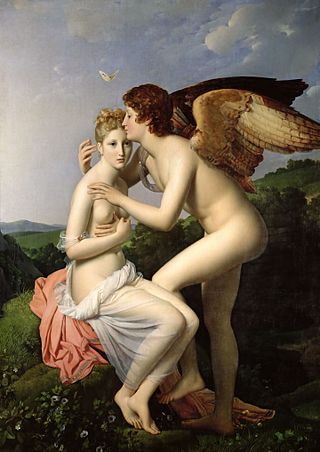
Cupid and Psyche is a story originally from Metamorphoses, written in the 2nd century AD by Lucius Apuleius Madaurensis. The tale concerns the overcoming of obstacles to the love between Psyche and Cupid or Amor, and their ultimate union in a sacred marriage. Although the only extended narrative from antiquity is that of Apuleius from the 2nd century AD, Eros and Psyche appear in Greek art as early as the 4th century BC. The story's Neoplatonic elements and allusions to mystery religions accommodate multiple interpretations, and it has been analyzed as an allegory and in light of folktale, Märchen or fairy tale, and myth.
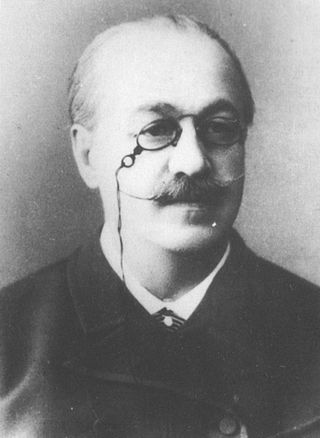
Lev Ivanovich Ivanov was a Russian ballet dancer and choreographer and later, Second Balletmaster of the Imperial Ballet. As a performer with the Imperial Ballet, he achieved prominence after performing as an understudy in a benefit performance of La Fille Mal Gardée. He is most famous as the choreographer of Acts II and IV of Swan Lake, which include the Dance of the Little Swans, Act II of Cinderella, and The Nutcracker, which he choreographed alongside Marius Petipa.
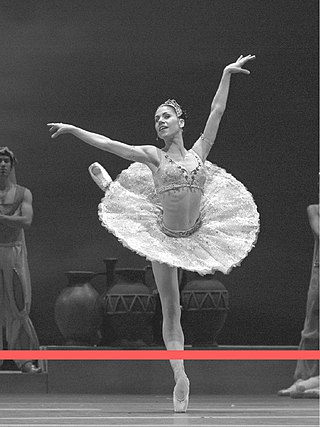
Paloma Herrera is a prominent Argentine ballet dancer, choreographer, and artistic director who was a principal dancer with American Ballet Theatre, where she worked for twenty-four years. She was the director of Colon Theater Ballet from 2017 until 2022.

In ballet, a variation is a solo dance. In a classical grand pas de deux, the ballerina and danseur each perform a variation.

Fiametta or Fiammetta, is a ballet in four acts and four scenes, choreographed by Arthur Saint-Léon to music by Ludwig Minkus, first presented by the Ballet of the Moscow Imperial Bolshoi Theatre on November 12–24, 1863 at the Moscow Imperial Bolshoi Theatre, Moscow, Russia, with Anna Sobeshchanskaya as Fiametta.

The Sacrifices to Cupid is a "grand ballet" in 1 Act/1 scene with choreography by Marius Petipa and music by Ludwig Minkus.

La Vestale is a grand ballet in three acts and four scenes with choreography by Marius Petipa and music by Mikhail Ivanov. The ballet was first presented by the Imperial Ballet on 17 February [O.S. 29 January] 1888 at the Imperial Mariinsky Theatre in St. Petersburg, Russia.

Le Réveil de Flore, is a ballet anacréontique in one act, with choreography by Marius Petipa and music by Riccardo Drigo, to a libretto written by Petipa and Lev Ivanov. First presented by the Imperial Ballet at Peterhof Palace on 6 August [O.S. 25 July] 1894.
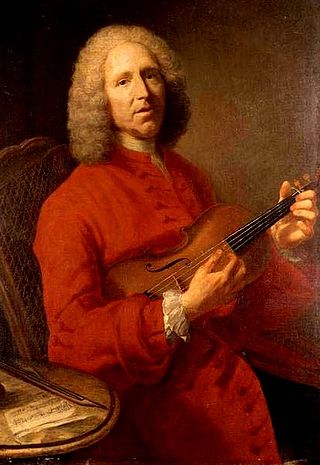
La naissance d'Osiris, ou La fête Pamilie is a one-act opera by Jean-Philippe Rameau, first performed on 12 October 1754 at Fontainebleau to celebrate the birth of the future King Louis XVI. The libretto is by Rameau's frequent collaborator Louis de Cahusac. Cahusac styled the work a ballet allégorique, but it is usually categorised as an acte de ballet. Its slender plot tells of Jupiter's announcement to a group of Egyptian shepherds of the birth of the god Osiris, who symbolises the baby prince. The piece may have started life as part of a larger work, Les beaux jours de l'Amour, an opéra-ballet Rameau and Cahusac planned but never completed for reasons which are still uncertain.

Les fêtes de l’Hymen et de l’Amour, ou Les dieux d'Egypte is an opéra-ballet in three entrées and a prologue by the French composer Jean-Philippe Rameau. The work was first performed on March 15, 1747, at the La Grande Ecurie, Versailles, and is set to a libretto by Louis de Cahusac. The opera was originally composed as part of the celebrations for the Dauphin’s marriage to Maria Josepha of Saxony. Les fêtes de l’Hymen proved to be a popular work and by the March 1776 it had been performed exactly 106 times. The librettist, Cahusac, was especially pleased with the ways in which he had succeeded in giving especial import to the supernatural elements of the work—the plot is based on Egyptian mythology—and to allow particular use of impressive large-scale stage machinery, which was much admired by the audience. The opera contains seven ballets, a consequence of Cahusac’s desire to further integrate dance and drama, which grew from the typical French devotion to ballet, particularly when allied with opera.

Les surprises de l'Amour is an opéra-ballet in two entrées and a prologue by the French composer Jean-Philippe Rameau. It was first performed in Versailles on 27 November 1748. The opera is set to a libretto by Gentil-Bernard. According to the usage of the time, it was originally just billed as a ballet and was only later classified by scholars as an opéra-ballet, although its content might more precisely ascribe it to the ballet héroïque genre.
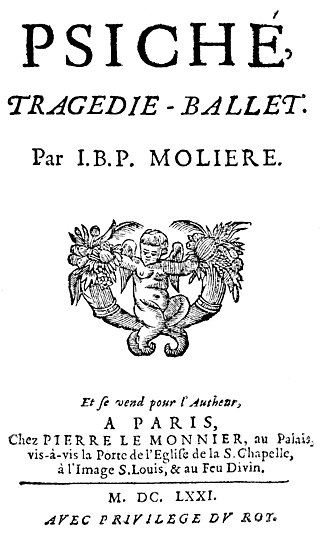
Psyché is a five-act tragédie-ballet, originally written as a prose text by Molière and versified in collaboration with Pierre Corneille and Philippe Quinault, with music composed by Jean-Baptiste Lully in 1671 and by Marc-Antoine Charpentier in 1684. The plot is based on the story of Cupid and Psyche in The Golden Ass, written in the 2nd century by Apuleius. It was first performed on 17 January 1671 before the royal court of Louis XIV at the Théâtre des Tuileries, with ballets by Pierre Beauchamps, Anthoine des Brosses, and Nicolas Delorge, and spectacular scenery and special effects designed by Carlo Vigarani.
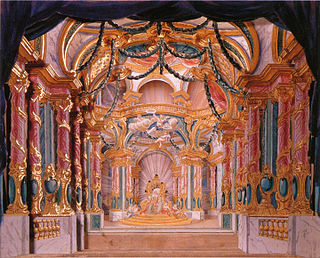
Les fêtes de Paphos is an opéra-ballet in three acts by the French composer Jean-Joseph Cassanéa de Mondonville. The work was described as a ballet héroïque on the title page of the printed score. Each act had a different librettist. Les fêtes de Paphos was first performed at the Académie royale de musique in Paris on 9 May 1758 and was a popular success. Mondonville recycled material from two of his previous operas for the first two acts, namely Erigone (1747) and Vénus et Adonis (1752), both originally composed for Madame de Pompadour's Théâtre des Petits Cabinets.
Les Aventures de Pélée is a ballet in three acts and five scenes with choreography by Marius Petipa and music by Ludwig Minkus, with additional music adapted from works by Léo Delibes. The libretto by Marius Petipa is derived from the Greek Myth concerning the Goddess Thetis and the circumstances surrounding her marriage, arranged by Jupiter, to the mortal Peleus.

Anacréon, ou L'amour fugitif is an opera-ballet in two acts by Luigi Cherubini with a French libretto by C. R. Mendouze. It was premiered on 4 October 1803 by the Paris Opéra at the Salle Montansier. The choreography was by Pierre-Gabriel Gardel. The work proved to be a complete failure, ending its run on 1 January 1804 after only seven performances. The subject matter, a love affair of the Ancient Greek poet Anacreon, was completely alien to the spirit of the time. One critic complained that in his protagonist Cherubini had represented "un vieux debauché déguisé en héros d'opéra".
Dana Stephensen is an Australian ballet dancer. She is a soloist of The Australian Ballet.

Die Dafne (1627) is an opera. Its libretto was written by Martin Opitz and its music was composed by Heinrich Schütz. It has traditionally been regarded as the first German opera, though it has also been proposed more recently that it was in fact a spoken drama with inserted song and ballet numbers.
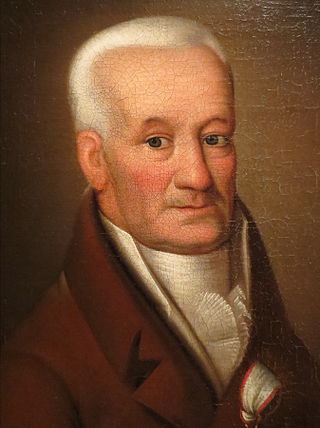
Vincenzo Galeotti was an Italian-born Danish dancer, choreographer and ballet master, who was influential as the director of the Royal Danish Ballet from 1775 until his death.














